Learn about the accomplishments of Rana Kumbha of Mewar, including his military conquests, musical talents, literary works, and contributions to the construction of prominent structures in the region.
हिंदी में पढ़ने के लिए नीचे स्क्रॉल करें
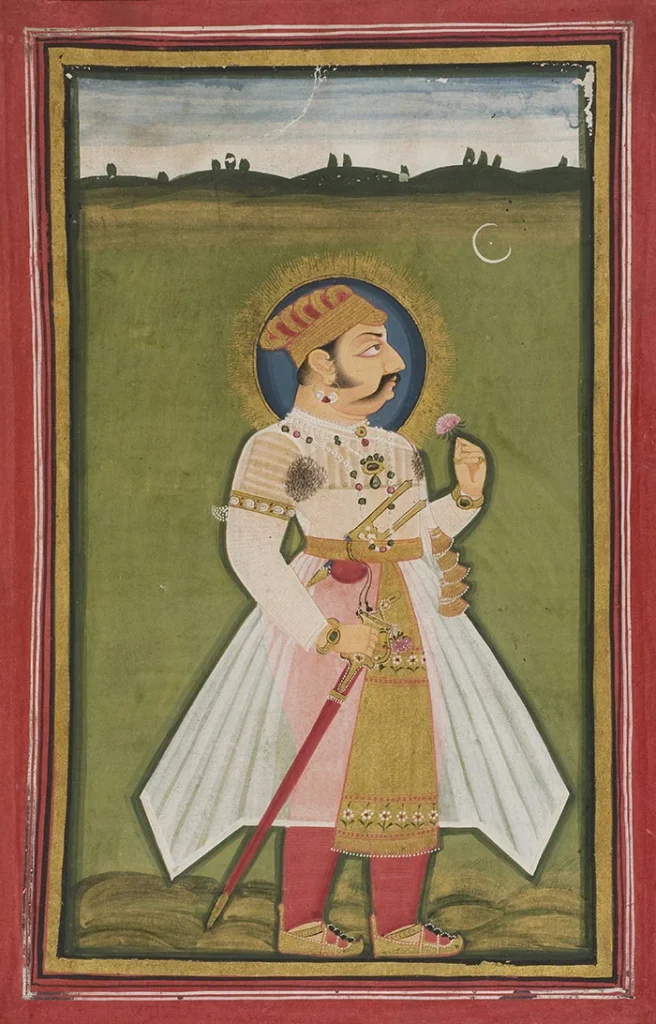
Maharana Kumbha, also known as Rana Kumbha, was a renowned ruler of the Mewar dynasty in Rajasthan, India. He was born in 1433 CE to Mokal, his father, and Saubhagyavati Parmar, his mother. After the death of his father, Kumbha was raised by his guardian, Ranmal, who played a significant role in his life.
When Kumbha was young, his father was murdered by the ruler of Mandore, Rao Jodha. In order to avenge his father’s death, Kumbha sought the help of his guardian, Ranmal. With Ranmal’s assistance, Kumbha was successful in defeating Rao Jodha and taking control of Mandore.
Ranmal’s influence in the Mewar court increased significantly after this victory, and he became one of the most powerful men in the kingdom. However, this power did not go unnoticed, and Ranmal soon found himself embroiled in a power struggle with the leader of the Sisodis, Raghavdev.
In an effort to eliminate his rival, Ranmal had Raghavdev killed. This act of violence did not sit well with Hansa, Raghavdev’s brother, who called back Chunda from Malwa to take revenge on Ranmal.
With the help of Bharamali, a trusted ally of Chunda, Ranmal was killed. Ranmal’s son Jodha fled to a village called Kahuni near Bikaner to avoid the same fate.
Chunda took advantage of the chaos and took control of the Rathore’s capital, Mandore. Despite these setbacks, Kumbha managed to hold onto his power and continued to rule the kingdom of Mewar with wisdom and fairness.
Maharana Kumbha is remembered as a wise and just ruler who was committed to protecting the interests of his people. He was a great patron of the arts and was responsible for commissioning several architectural marvels, including the famous Kumbhalgarh Fort. His legacy continues to inspire the people of Rajasthan to this day.
How many wars did Rana Kumbha fight? Details Below!
The Treaty of Anwal-Bawal- Rajasthan GK
The Treaty of Anwal-Bawal was signed in 1453 AD between Jodha, the ruler of Marwar, and Kumbha, the ruler of Mewar, to settle a longstanding border dispute between their kingdoms.
As per the treaty, Sojat, a town in Pali district, was made the border between Mewar and Marwar. Mandore, which had been captured by Kumbha, was returned to Jodha. In addition, Maharana Kumbha’s son Raymal was married to Jodha’s daughter Shringar Kanwar, to cement the peace agreement.
This treaty was a significant milestone in the history of Rajasthan, as it helped establish a lasting peace between two powerful kingdoms that had been at odds with each other for years. The marriage alliance between the two royal families also helped strengthen their relationship and fostered a sense of unity and cooperation between Mewar and Marwar.
The Battle of Sarangpur- Rajasthan GK
The Battle of Sarangpur took place in 1437 AD between Maharana Kumbha and Mahmud Khilji, the ruler of Malwa. Here are some key points about the battle:
- Mahmud Khilji had given asylum to Mahapa Panwar and Ekka, who were the killers of Kumbha’s father, Mokal.
- Kumbha had given control of Sarangpur to Mahmud Khilji’s rebel Umar Khan, with military aid from Kumbha.
- Both Kumbha and Mahmud Khilji had ambitions for expanding their respective empires.
In the battle, Kumbha emerged victorious and captured Mahmud Khilji. To commemorate his victory, Kumbha had the Vijay Stambh (Tower of Victory) constructed in Chittor. The tower stands as a symbol of Kumbha’s military prowess and strategic acumen.
The Treaty of Champaner- Rajasthan GK
The Treaty of Champaner was signed in 1456 AD between Mahmud Khilji of Malwa and Qutbuddin Shah of Gujarat. Here are some key points about the treaty:
- The objective of the treaty was to defeat Rana Kumbha and to gain control over Gujarat, the southern part of Mewar, and the special part of Mewar and Ahirwada.
- The treaty was signed between Mahmud Khilji’s representative Taj Khan and Qutbuddin Shah.
- The terms of the treaty included a pledge of mutual support in case of an attack by any external force and the sharing of spoils of war.
- The treaty also included provisions for resolving disputes through arbitration and the return of prisoners of war.
- Despite the treaty, Kumbha continued to resist Khilji’s expansionist ambitions and the two sides engaged in several battles over the next few years.
The Battle of Badnaur- Rajasthan GK
The Battle of Badnaur took place in 1457 AD in Bhilwara, Rajasthan, between Maharana Kumbha and the combined forces of Malwa and Gujarat. Here are some key points about the battle:
- Kumbha defeated the combined forces of Malwa and Gujarat, as recorded in the Kirti Stambha Prasasti and Rasik Priya.
- Kumbha also defeated Sahasmal Deora of Sirohi, who had assisted Sultan Qutubuddin Shah of Gujarat.
- Kumbha sent an army led by Narasimh Dodia to fight against Sahasmal Deora.
The Battle of Badnaur is significant because it showcases Kumbha’s military strength and strategic planning, as he was able to defeat a larger and more powerful coalition of enemies. This victory also helped consolidate Kumbha’s position as the ruler of Mewar and allowed him to expand his empire.
Succession struggle of Nagaur- Rajasthan GK
After the death of Feroze Khan, his sons Shams Khan and Mujahid Khan fought for succession in Nagaur. Kumbha supported Shams Khan and defeated Mujahid Khan. However, when Shams Khan started fortifying Nagaur Fort, Kumbha attacked Nagaur. Shams Khan fled to Gujarat and married the daughter of Qutubuddin Shah. Together, Qutubuddin Shah and Shams Khan attacked Mewar, but Kumbha emerged victorious. The succession struggle of Nagaur ultimately led to a dispute between Mewar and Gujarat.
Cultural achievements of Rana Kumbha of Mewar- Rajasthan GK
- Name: Vijay Stambha
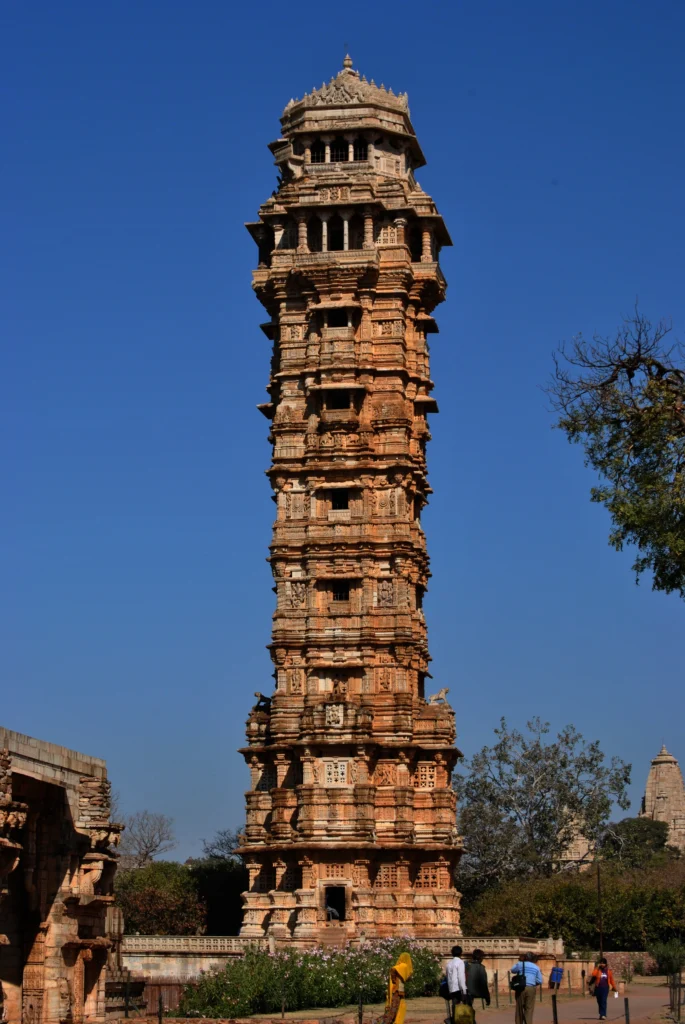
Other Names: Kirti Stambha, Vishnu Dwaz, Garuda Dwaz, Museum of Idols, Encyclopedia of Indian Sculpture
Description:
- Height: 122 feet
- Width: 30 feet
- Number of floors: 9
- No idol on the 8th floor
- The Arabic word “Allah” was written nine times on the third floor
Architects:
- Jaita
- Poonja
- Poma
- Napa (named on the fifth floor)
Notable Authors:
- Atri
- Mahesh (authors of the Eulogy of Kirti Stambha)
History:
- Rebuilt by Mewar Maharana Swaroop Singh
- James Todd compared it to Qutub Minar
- Ferguson compared it with the Tarzan Tower of Rome
- The first building in Rajasthan to have a postal stamp issued in its honor
Symbols:
- Rajasthan Police
- Rajasthan Board of Secondary Education
- Abhinav Bharat (Organization of Veer Savarkar)
2. Jain Kirti Stambha:
- Located in Chittor Fort
- The 7-story building built in the 12th century by Jain merchant Jija Shah Bagherwal
- Dedicated to Lord Adinath (Rishabhdev), also called Adinath Stambh
Forts Constructed By Maharana Kumbha of Mewar- Rajasthan G
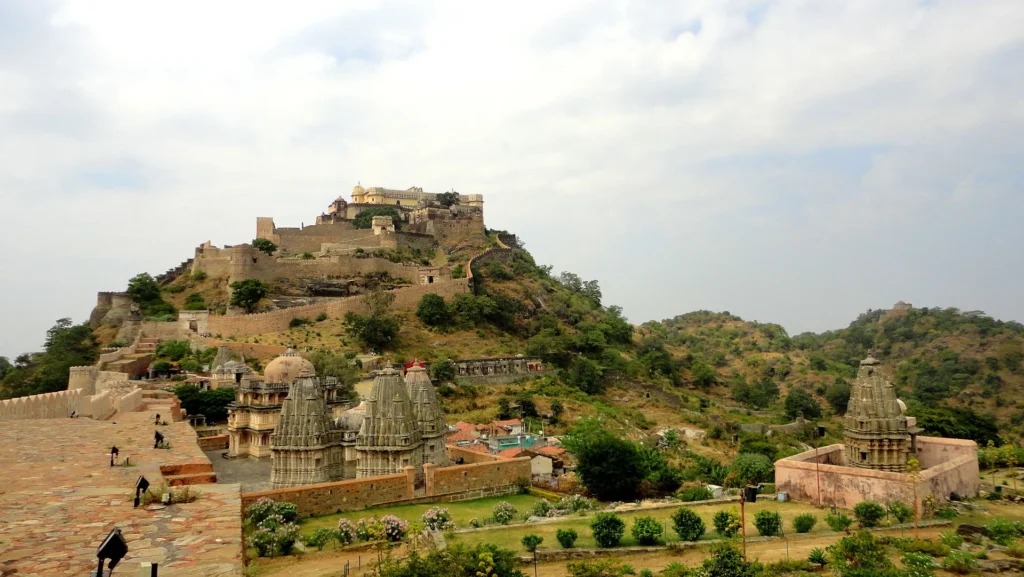
Maharana Kumbha constructed 32 forts out of 84 in Mewar, according to Kaviraja Shyamaldas Ji’s book Veer Vinod. Here are some key points about some of the forts built by Kumbha:
- Kumbhalgarh – Located in Rajsamand, it was the exigency capital of Mewar and is known as the border sentinel of Mewar-Marwar. The topmost palace is Katargarh, which was Kumbha’s private residence. It is called the eye of Mewar.
- Achalgarh – Located in Sirohi, Kumbha got it rebuilt in 1452 AD.
- Basantgarh (Basanti Durg) – Located in Sirohi.
- Machan Fort – Located in Sirohi, it was built to control the Mer tribe.
- Bhomat Durg – Located in Udaipur, it was built to control the Bhils.
- Bairath Durg – Located in Bhilwara.
Temples Constructed By Maharana Kumbha of Mewar- Rajasthan GK
Maharana Kumbha was known for his patronage of the arts, including temple construction. Here are some of the temples he built:
- Kumbhaswamy Temples of Lord Vishnu – These temples were built in Chittorgarh, Kumbhalgarh, and Achalgarh.
- Vishnu Temple (Meera Temple) in Ekling Ji – This temple is dedicated to Lord Vishnu and is also known as the Meera Temple.
- Shringar Chanwari Temple (Shantinath Jain Temple) – This temple was built by Vela Bhandari, the treasurer of Chittor.
- Ranakpur Jain Temple – These temples were built by Jain merchant Dharankshah in 1439 AD. The main temple, the Chamukha Temple, has the idol of Lord Adinath and is famous for its 1444 pillars. The architect of the temple was Depak.
Literatures Of Maharana Kumbha- Rajasthan GK
- Kumbha was a skilled musician who played the veena, as mentioned in the Kirti Stambh Eulogy.
- His music guru was Sarang Vyas.
- He wrote several books on music, including
- Sudha Prabandh, Kamaraj Ratisar (7 parts), Sangeet Sudha, Sangeet Mimansha, Sangeet Kram Deepika, and Sangeet Raj (Part 5).
- Kumbha also compiled several Ratna Kosh (treasuries) on various subjects, including
- Pathya Ratna Kosh, Geet Ratna Kosh, Nritya Ratna Kosh, Vadhya Ratna Kosh, and Ras Ratna Kosh.
- He wrote commentaries on several works, such as
- Rasik Priya on Jayadev’s Geet Govind, Sarangadhar’s Sangeet Ratnakar, and Banabhatta’s Chandishatak.
- Kumbha was also a playwright, and he wrote four plays:
- Murari Sangeet in Kannada, Ras Nandini in Mewari, Nandini Vriti in Marathi, and Atulya Chaturi in Sanskrit.
- He was a scholar of Marathi, Kannada, and Mewari languages.
- Commentaries:
- “Rasik Priya” on Jayadev’s “Geet Govind”
- Commentary on Sarangadhar’s “Sangeet Ratnakar”
- Commentary on Banabhatta’s “Chandishatak”
- Plays:
- “Murari Sangeet” in Kannada
- “Ras Nandini” in Mewari
- “Nandini Vriti” in Marathi
- “Atulya Chaturi” in Sanskrit
- Kumbha was a scholar of Marathi, Kannada, and Mewari languages.
Titles Of Maharana Kumbha- Rajasthan GK
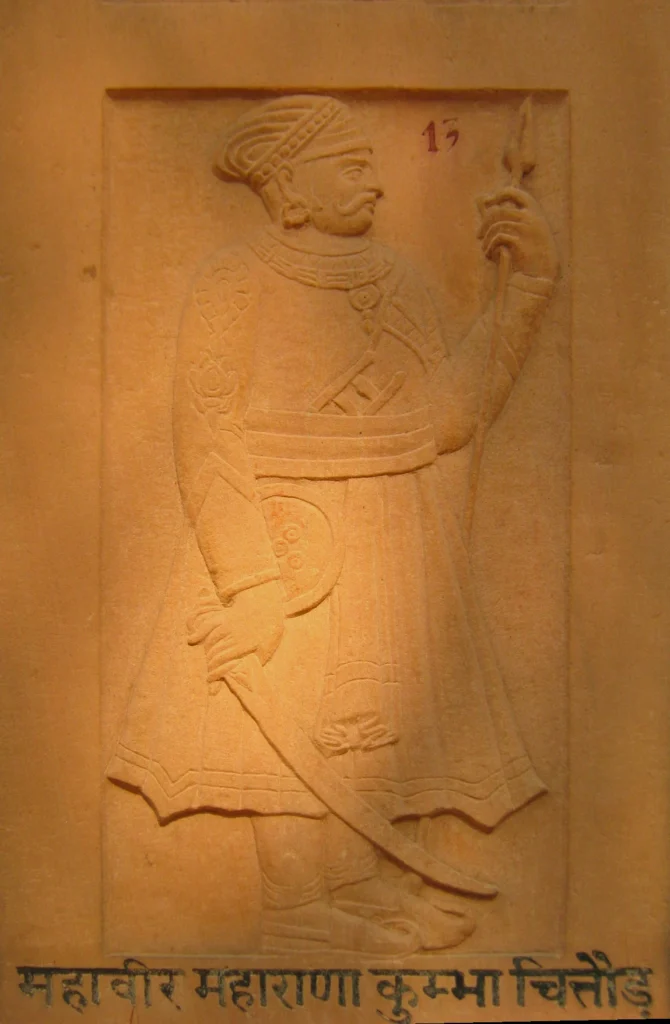
- Hindu Surtana (protector of Hindus)
- Abhinav Bharathacharya / Navya Bharata (Music)
- Rana Rasou (Literature)
- Hal Guru (Hill Fortress Winner)
- Chap guru (archer)
- Param Bhagwat (Vishnu devotee)
- Adi Varaha (Vishnu devotee)
Who Killed Maharana Kumbha And Why?- Rajasthan GK
There is no historical consensus on who killed Maharana Kumbha, the king of Mewar. Some sources suggest that he was assassinated by his own son, Udaysimha, who was unhappy with his father’s decision to disinherit him in favor of his younger brother, Raimal. Others speculate that Kumbha may have been killed by his enemies, possibly in retaliation for his military victories and territorial expansion. However, the exact reason and perpetrator of his death remain a matter of debate and speculation among historians
Kirti Stambah Prasasti: Writer And Architect.
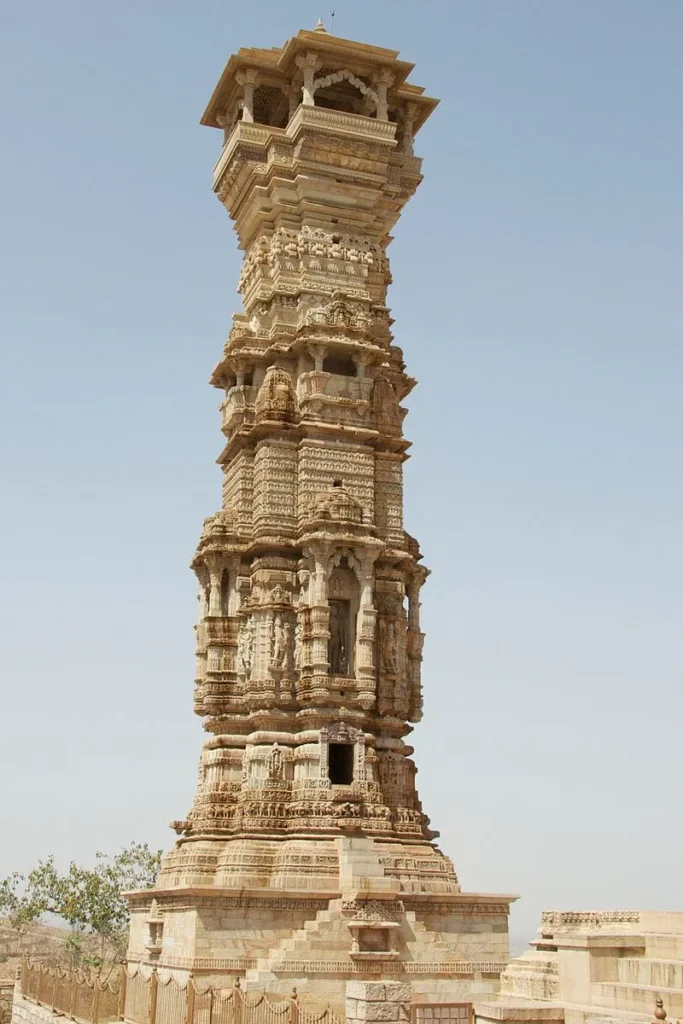
Date: 3 December 1460 AD (Margashirsha Krishna Panchami Vikram Samvat 1517)
Eulogists: Atri Bhatt and Mahesh Bhatt
Contents:
- Written on 8 rocks, but only 2 remain
- Provides information about the Guhil dynasty rulers of Mewar from Bapa to Kumbha
- Describes Kumbha’s conquests, including Mandore, Sapadalaksha, Narana, Basantpur, Abu, Khandela, Jangladesha, Nagaur, Gujarat, Malwa, and more
- Gives details about the defeat of the combined armies of Malwa and Gujarat
- Lists Kumbha’s books, such as Sangeetraj, Chandishakta, Teeka of Geetgovind, and Sudha-Prabandha
- Mentions the 4 plays written by Kumbha, named Rajguru, Danaguru, Shailguru, and Abhinav Bharathacharya
- Provides information about the date of construction work done in Kirti Stambha, Kumbhalgarh, Achalgarh, etc.
- Mentions that Kumbha composed a treatise called Stambha Raj on the subject of Kirti Stambhas, which he got carved on the rocks of ‘Kirti Stambha’. According to it, he composed this scripture by looking at the opinions of Jai and Aparajit (son of Brahma).
Important Questions On Maharana Kumbha for Rajasthan State Exams Like RAS Bharti, Rajasthan Police, Reet, Constable Bharti, and so on.
- What were Kumbha’s significant achievements during his reign as the ruler of Mewar?
- What were the key battles fought by Kumbha and what was their outcome?
- What were the contributions of Kumbha in the field of literature and music?
- What is the significance of the Kirti Stambh Eulogy and what information does it provide about Kumbha and his reign?
- How did Kumbha manage to maintain his power and expand his kingdom despite facing several challenges and rebellions?
- What was the role of Kumbha in the struggle for succession in Nagaur and how did it lead to a dispute between Mewar and Gujarat?
- What was the significance of Kumbhalgarh Fort and how did Kumbha’s construction of it impact Mewar’s defense system?
- What were Kumbha’s diplomatic strategies and how did he use them to strengthen Mewar’s position in the region?
- How did Kumbha’s patronage of the arts and literature impact the cultural landscape of Mewar?
- What was the impact of Kumbha’s reign on the subsequent rulers of Mewar and the region as a whole?
महाराणा कुम्भा: राजस्थान जीके के लिए महत्वपूर्ण तथ्य और नोट्स
- महाराणा कुम्भा, जिन्हें राणा कुम्भा के नाम से भी जाना जाता है, राजस्थान, भारत में मेवाड़ राजवंश के एक प्रसिद्ध शासक थे। उनका जन्म 1433 सीई में उनके पिता मोकल और उनकी मां सौभाग्यवती परमार के घर हुआ था। अपने पिता की मृत्यु के बाद, कुंभा का पालन-पोषण उनके अभिभावक रणमल ने किया, जिन्होंने उनके जीवन में महत्वपूर्ण भूमिका निभाई।
- जब कुंभा छोटा था, उसके पिता की हत्या मंडोर के शासक राव जोधा ने कर दी थी। अपने पिता की मृत्यु का बदला लेने के लिए, कुंभा ने अपने संरक्षक रणमल की मदद मांगी। रणमल की सहायता से, कुंभ राव जोधा को हराने और मंडोर पर अधिकार करने में सफल रहा।
- इस जीत के बाद मेवाड़ दरबार में रणमल का प्रभाव काफी बढ़ गया और वह राज्य के सबसे शक्तिशाली व्यक्तियों में से एक बन गया। हालाँकि, इस शक्ति पर किसी का ध्यान नहीं गया और रणमल ने जल्द ही खुद को सिसोदियों के नेता राघवदेव के साथ सत्ता संघर्ष में उलझा हुआ पाया।
- अपने प्रतिद्वंद्वी को खत्म करने के प्रयास में, रणमल ने राघवदेव को मार डाला। हिंसा का यह कृत्य राघवदेव के भाई हंसा को अच्छा नहीं लगा, जिसने रणमल से बदला लेने के लिए मालवा से चुंडा को वापस बुला लिया।
- चुंडा के विश्वस्त सहयोगी भारमाली की सहायता से रणमल मारा गया। रणमल का पुत्र जोधा उसी भाग्य से बचने के लिए बीकानेर के पास कहुनी नामक गाँव में भाग गया।
- चुंडा ने अराजकता का फायदा उठाया और राठौड़ की राजधानी मंडोर पर अधिकार कर लिया। इन असफलताओं के बावजूद, कुंभा ने अपनी शक्ति पर कब्जा करने में कामयाबी हासिल की और ज्ञान और निष्पक्षता के साथ मेवाड़ के राज्य पर शासन करना जारी रखा।
- महाराणा कुम्भा को एक बुद्धिमान और न्यायप्रिय शासक के रूप में याद किया जाता है जो अपने लोगों के हितों की रक्षा के लिए प्रतिबद्ध थे। वह कला के एक महान संरक्षक थे और प्रसिद्ध कुम्भलगढ़ किले सहित कई वास्तुशिल्प चमत्कारों को शुरू करने के लिए जिम्मेदार थे। उनकी विरासत आज भी राजस्थान के लोगों को प्रेरित करती है।
राणा कुम्भा ने कितने युद्ध लड़े? नीचे दिए गए विवरण!
आंवल-बावल की संधि- राजस्थान जी.के
- आंवल-बावल की संधि 1453 ईस्वी में मारवाड़ के शासक जोधा और मेवाड़ के शासक कुंभा के बीच उनके राज्यों के बीच लंबे समय से चले आ रहे सीमा विवाद को निपटाने के लिए हुई थी।
- संधि के अनुसार, पाली जिले के एक शहर सोजत को मेवाड़ और मारवाड़ के बीच की सीमा बना दिया गया था। मंडोर, जिसे कुंभ ने कब्जा कर लिया था, जोधा को वापस कर दिया गया था। इसके अलावा, महाराणा कुम्भा के पुत्र रायमल का विवाह जोधा की पुत्री श्रृंगार कंवर से हुआ, जिससे शांति समझौता पक्का हो गया।
- यह संधि राजस्थान के इतिहास में एक महत्वपूर्ण मील का पत्थर थी, क्योंकि इसने दो शक्तिशाली राज्यों के बीच स्थायी शांति स्थापित करने में मदद की, जो वर्षों से एक-दूसरे के साथ थे। दो शाही परिवारों के बीच विवाह गठबंधन ने भी उनके रिश्ते को मजबूत करने में मदद की और मेवाड़ और मारवाड़ के बीच एकता और सहयोग की भावना को बढ़ावा दिया।
सारंगपुर की लड़ाई- राजस्थान जी.के
सारंगपुर का युद्ध 1437 ई. में महाराणा कुम्भा और मालवा के शासक महमूद खिलजी के बीच हुआ था। पेश हैं इस जंग से जुड़ी कुछ अहम बातें:
- महमूद खिलजी ने महापा पंवार और एक्का को शरण दी थी, जो कुंभा के पिता मोकल के हत्यारे थे।
- कुंभा ने सैन्य सहायता से महमूद खिलजी के विद्रोही उमर खान को सारंगपुर का नियंत्रण दिया था।
- कुंभा और महमूद खिलजी दोनों की अपने-अपने साम्राज्य का विस्तार करने की महत्वाकांक्षा थी।
युद्ध में, कुंभ विजयी हुआ और उसने महमूद खिलजी को बंदी बना लिया। अपनी जीत के उपलक्ष्य में, कुंभ ने चित्तौड़ में विजय स्तंभ (विजय का टॉवर) बनवाया था। टॉवर कुंभा के सैन्य कौशल और रणनीतिक कौशल के प्रतीक के रूप में खड़ा है।
चंपानेर की संधि- राजस्थान जी.के
चंपानेर की संधि 1456 ई. में मालवा के महमूद खिलजी और गुजरात के कुतुबुद्दीन शाह के बीच हुई थी। संधि के बारे में कुछ मुख्य बातें इस प्रकार हैं:
- इस संधि का उद्देश्य राणा कुम्भा को परास्त करना तथा गुजरात, मेवाड़ के दक्षिणी भाग तथा मेवाड़ के विशेष भाग तथा अहिरवाड़ा पर अधिकार करना था।
- महमूद खिलजी के प्रतिनिधि ताज खां और कुतुबुद्दीन शाह के बीच संधि पर हस्ताक्षर किए गए थे।
- संधि की शर्तों में किसी बाहरी ताकत के हमले की स्थिति में आपसी समर्थन की प्रतिज्ञा और युद्ध की लूट का बंटवारा शामिल था।
- संधि में मध्यस्थता के माध्यम से विवादों को सुलझाने और युद्ध बंदियों की वापसी के प्रावधान भी शामिल थे।
- संधि के बावजूद, कुंभ ने खिलजी की विस्तारवादी महत्वाकांक्षाओं का विरोध करना जारी रखा और दोनों पक्ष अगले कुछ वर्षों में कई लड़ाइयों में लगे रहे।
बदनौर की लड़ाई- राजस्थान जी.के
बदनौर का युद्ध 1457 ई. में राजस्थान के भीलवाड़ा में महाराणा कुम्भा और मालवा और गुजरात की संयुक्त सेना के बीच हुआ था। पेश हैं इस जंग से जुड़ी कुछ अहम बातें:
- कुंभ ने मालवा और गुजरात की संयुक्त सेना को हराया, जैसा कि कीर्ति स्तंभ प्रशस्ति और रसिक प्रिया में दर्ज है।
- कुंभा ने सिरोही के सहसमल देवड़ा को भी हराया, जिसने गुजरात के सुल्तान कुतुबुद्दीन शाह की सहायता की थी।
- कुम्भा ने सहसमल देवड़ा के खिलाफ लड़ने के लिए नरसिंह डोडिया के नेतृत्व में एक सेना भेजी।
बदनौर की लड़ाई महत्वपूर्ण है क्योंकि यह कुंभा की सैन्य ताकत और रणनीतिक योजना को दर्शाती है, क्योंकि वह दुश्मनों के एक बड़े और अधिक शक्तिशाली गठबंधन को हराने में सक्षम था। इस जीत ने मेवाड़ के शासक के रूप में कुंभा की स्थिति को मजबूत करने में मदद की और उसे अपने साम्राज्य का विस्तार करने की अनुमति दी
नागौर-राजस्थान जीके का उत्तराधिकार संघर्ष
फिरोज खान की मृत्यु के बाद, उनके बेटों शम्स खान और मुजाहिद खान ने नागौर में उत्तराधिकार के लिए लड़ाई लड़ी। कुंभा ने शम्स खान का समर्थन किया और मुजाहिद खान को हराया। हालाँकि, जब शम्स खान ने नागौर किले की किलेबंदी शुरू की, तो कुंभ ने नागौर पर आक्रमण कर दिया। शम्स खान गुजरात भाग गया और कुतुबुद्दीन शाह की बेटी से शादी कर ली। कुतुबुद्दीन शाह और शम्स खान ने मिलकर मेवाड़ पर हमला किया, लेकिन कुंभ विजयी हुआ। नागौर के उत्तराधिकार संघर्ष ने अंततः मेवाड़ और गुजरात के बीच विवाद को जन्म दिया।
मेवाड़ के राणा कुंभा की सांस्कृतिक उपलब्धियां- राजस्थान जी.के
- नाम : विजय स्तम्भ
अन्य नाम: कीर्ति स्तंभ, विष्णु ध्वज, गरुड़ ध्वज, मूर्तियों का संग्रहालय, भारतीय मूर्तिकला का विश्वकोश
विवरण:
• ऊंचाई: 122 फीट
• चौड़ाई: 30 फुट
• मंजिलों की संख्या: 9
• आठवीं मंजिल पर कोई मूर्ति नहीं है
• तीसरी मंजिल पर अरबी शब्द “अल्लाह” नौ बार लिखा गया था
आर्किटेक्ट्स:
• जैता
• पूंजा
• पोमा
• नापा (पांचवीं मंजिल पर नामित)
उल्लेखनीय लेखक:
• अत्रि
• महेश (कीर्ति स्तम्भ के स्तवन के लेखक)
इतिहास:
• मेवाड़ महाराणा स्वरूप सिंह द्वारा पुनर्निर्माण किया गया
• जेम्स टॉड ने इसकी तुलना कुतुब मीनार से की
• फर्ग्यूसन ने इसकी तुलना रोम के टार्ज़न टॉवर से की
• राजस्थान का पहला भवन जिसके सम्मान में डाक टिकट जारी किया गया है
प्रतीक:
• राजस्थान पुलिस
• राजस्थान माध्यमिक शिक्षा बोर्ड
• अभिनव भारत (वीर सावरकर का संगठन) - जैन कीर्ति स्तम्भ:
• चित्तौड़ किले में स्थित है
• जैन व्यापारी जीजा शाह बघेरवाल द्वारा 12वीं शताब्दी में निर्मित 7 मंजिला इमारत
• भगवान आदिनाथ (ऋषभदेव) को समर्पित, जिसे आदिनाथ स्तंभ भी कहा जाता है
मेवाड़ के महाराणा कुम्भा द्वारा निर्मित किले- राजस्थान जी.के
कविराज श्यामलदास जी की पुस्तक वीर विनोद के अनुसार महाराणा कुम्भा ने मेवाड़ में 84 में से 32 दुर्गों का निर्माण कराया।
कुंभ द्वारा निर्मित कुछ किलों के बारे में कुछ मुख्य बातें इस प्रकार हैं:
- कुम्भलगढ़ – राजसमंद में स्थित, यह मेवाड़ की आकस्मिक राजधानी थी और मेवाड़-मारवाड़ के सीमा प्रहरी के रूप में जाना जाता है। सबसे ऊपर का महल कटारगढ़ है, जो कुम्भा का निजी आवास था। इसे मेवाड़ की आंख कहा जाता है।
- अचलगढ़ – सिरोही में स्थित कुम्भा ने 1452 ई. में इसका पुनर्निर्माण करवाया।
- बसंतगढ़ (बसंती दुर्ग)- सिरोही में स्थित है।
- मचान किला – सिरोही में स्थित, इसे मेर जनजाति को नियंत्रित करने के लिए बनाया गया था।
- भोमट दुर्ग – उदयपुर में स्थित, इसे भीलों को नियंत्रित करने के लिए बनाया गया था।
- बैराठ दुर्ग – भीलवाड़ा में स्थित है।
मेवाड़ के महाराणा कुम्भा द्वारा निर्मित मंदिर- राजस्थान जी.के
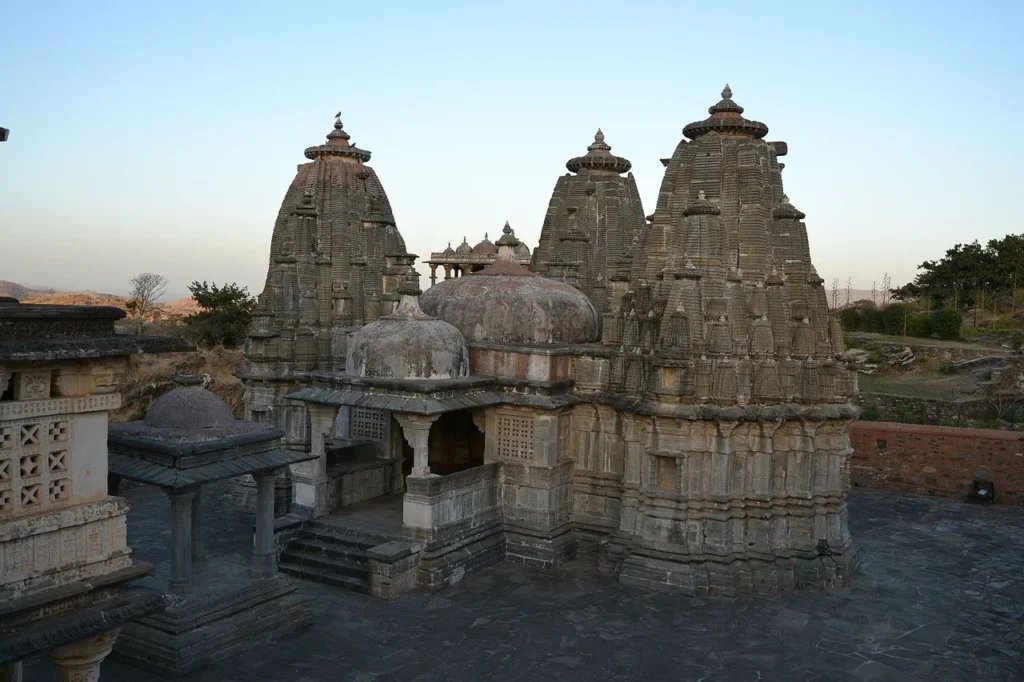
महाराणा कुम्भा को मंदिर निर्माण सहित कलाओं के संरक्षण के लिए जाना जाता था। यहाँ उनके द्वारा बनवाए गए कुछ मंदिर हैं:
- भगवान विष्णु के कुंभस्वामी मंदिर – इन मंदिरों का निर्माण चित्तौड़गढ़, कुंभलगढ़ और अचलगढ़ में हुआ था।
- एकलिंग जी में विष्णु मंदिर (मीरा मंदिर) – यह मंदिर भगवान विष्णु को समर्पित है और इसे मीरा मंदिर के नाम से भी जाना जाता है।
- श्रृंगार चंवरी मंदिर (शांतिनाथ जैन मंदिर) – इस मंदिर का निर्माण चित्तौड़ के कोषाध्यक्ष वेला भंडारी ने करवाया था।
रणकपुर जैन मंदिर – इन मंदिरों का निर्माण जैन व्यापारी धरणशाह ने 1439 ई. में करवाया था। मुख्य मंदिर, चामुखा मंदिर में भगवान आदिनाथ की मूर्ति है और यह अपने 1444 स्तंभों के लिए प्रसिद्ध है। मंदिर के वास्तुकार दीपक थे।
महाराणा कुम्भा का साहित्य- राजस्थान जी.के
• कुंभ एक कुशल संगीतज्ञ था, जो वीणा बजाता था, जैसा कि कीर्ति स्तंभ स्तुति में वर्णित है।
• उनके संगीत गुरु सारंग व्यास थे।
• उन्होंने संगीत सहित कई पुस्तकें लिखीं
o सुधा प्रबंध, कामराज रतीसर (7 भाग), संगीत सुधा, संगीत मीमांशा, संगीत क्रम दीपिका, और संगीत राज (भाग 5)।
• कुंभ ने विभिन्न विषयों पर कई रत्न कोष (खजाने) भी संकलित किए, जिनमें शामिल हैं
ॐ पथ्य रत्न कोष, गीत रत्न कोष, नृत्य रत्न कोष, वाध्य रत्न कोष और रस रत्न कोष।
• कुम्भा एक नाटककार भी थे, और उन्होंने चार नाटक लिखे:
o कन्नड़ में मुरारी संगीत, मेवाड़ी में रास नंदिनी, मराठी में नंदिनी वृति और संस्कृत में अतुल्य चतुरी।
• वह मराठी, कन्नड़ और मेवाड़ी भाषा के विद्वान थे।
टिप्पणियाँ:
जयदेव के “गीत गोविंद” पर “रसिक प्रिया”
o सारंगधर की “संगीत रत्नाकर” पर टिप्पणी
बाणभट्ट की “चंडीष्टक” पर टिप्पणी
• खेलता है:
ओ “मुरारी संगीत” कन्नड़ में
मेवाड़ी में ओ “रस नंदिनी”
ओ “नंदिनी वृति” मराठी में
ओ “अतुल्य चतुरी” संस्कृत में
• कुम्भा मराठी, कन्नड़ और मेवाड़ी भाषा के विद्वान थे।
महाराणा कुम्भा की उपाधियाँ- राजस्थान जी.के
- हिन्दू सुरताना (हिंदुओं का रक्षक)
- अभिनव भरताचार्य/नव्य भारत (संगीत)
- राणा रसौ (साहित्य)
- हाल गुरु (पहाड़ी किले विजेता)
- चाप गुरु (तीरंदाज)
- परम भागवत (विष्णु भक्त)
- आदि वराह (विष्णु भक्त)
महाराणा कुम्भा को किसने मारा और क्यों?- राजस्थान जी.के
मेवाड़ के राजा महाराणा कुम्भा की हत्या किसने की इस पर कोई ऐतिहासिक सहमति नहीं है। कुछ स्रोतों से पता चलता है कि उनकी हत्या उनके ही बेटे उदयसिम्हा ने की थी, जो अपने छोटे भाई रायमल के पक्ष में अपने पिता के फैसले से नाखुश थे। अन्य लोग अनुमान लगाते हैं कि कुंभ को उसके शत्रुओं द्वारा मार दिया गया हो सकता है, संभवतः उसकी सैन्य जीत और क्षेत्रीय विस्तार के प्रतिशोध में। हालाँकि, उनकी मृत्यु का सटीक कारण और अपराधी इतिहासकारों के बीच बहस और अटकलों का विषय बना हुआ है
कीर्ति स्तम्भ प्रशस्ति: लेखक और वास्तुकार।
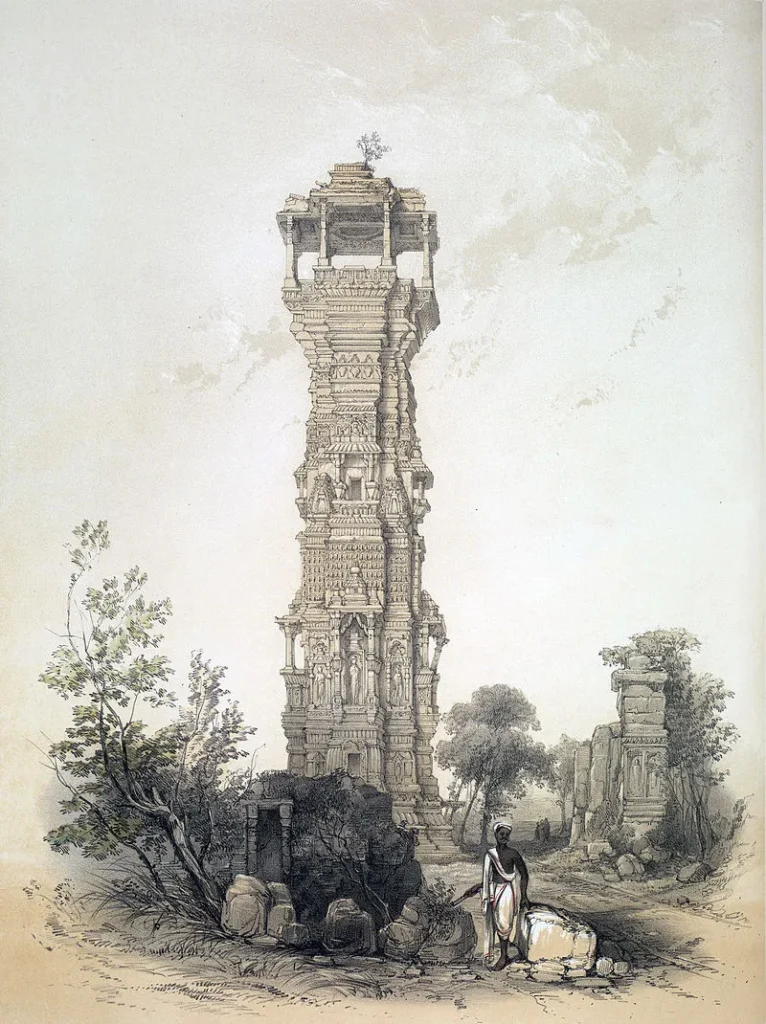
दिनांक: 3 दिसम्बर 1460 ई. (मार्गशीर्ष कृष्ण पंचमी विक्रम संवत 1517)
स्तवन: अत्रि भट्ट और महेश भट्ट
सामग्री:
• 8 शिलाओं पर लिखा है, लेकिन केवल 2 ही शेष हैं
• बापा से कुंभ तक मेवाड़ के गुहिल वंश के शासकों के बारे में जानकारी प्रदान करता है
• मंडोर, सपादलक्ष, नाराणा, बसंतपुर, आबू, खंडेला, जंगलदेश, नागौर, गुजरात, मालवा, और अन्य सहित कुंभ की विजय का वर्णन करता है
• मालवा और गुजरात की संयुक्त सेनाओं की पराजय का विवरण देता है
• कुंभ की पुस्तकों की सूची, जैसे संगीतराज, चंडीशक्त, गीतगोविंद का टीका, और सुधा-प्रबंध
• कुम्भा द्वारा लिखित 4 नाटकों का उल्लेख है, जिनके नाम राजगुरु, दानगुरु, शैलगुरु और अभिनव भरताचार्य हैं।
• कीर्ति स्तंभ, कुम्भलगढ़, अचलगढ़ आदि में किये गये निर्माण कार्य की तिथि की जानकारी प्रदान करता है।
• उल्लेख है कि कुम्भ ने कीर्ति स्तम्भों के विषय पर स्तम्भराज नामक ग्रन्थ की रचना की, जिसे उन्होंने ‘कीर्ति स्तम्भ’ की शिलाओं पर तराशा। इसके अनुसार उन्होंने जय और अपराजित (ब्रह्मा के पुत्र) के मतों को देखकर इस शास्त्र की रचना की।
राजस्थान राज्य परीक्षाओं जैसे आरएएस भारती, राजस्थान पुलिस, रीट, कांस्टेबल भारती आदि के लिए महाराणा कुंभा पर महत्वपूर्ण प्रश्न।
- मेवाड़ के शासक के रूप में कुंभा की महत्वपूर्ण उपलब्धियाँ क्या थीं?
- कुम्भ द्वारा लड़ी गई प्रमुख लड़ाइयाँ कौन-सी थीं और उनका परिणाम क्या था?
- साहित्य और संगीत के क्षेत्र में कुम्भ का क्या योगदान था?
- कीर्ति स्तंभ स्तुति का क्या महत्व है और यह कुंभ और उसके शासनकाल के बारे में क्या जानकारी प्रदान करता है?
- कुम्भा ने कई चुनौतियों और विद्रोहों का सामना करने के बावजूद अपनी शक्ति को बनाए रखने और अपने राज्य का विस्तार करने का प्रबंधन कैसे किया?
- नागौर में उत्तराधिकार के संघर्ष में कुम्भा की क्या भूमिका थी और इसने मेवाड़ और गुजरात के बीच विवाद को कैसे जन्म दिया?
- कुंभलगढ़ किले का क्या महत्व था और कुंभ के निर्माण ने मेवाड़ की रक्षा प्रणाली को कैसे प्रभावित किया?
- कुंभा की कूटनीतिक रणनीतियाँ क्या थीं और उन्होंने क्षेत्र में मेवाड़ की स्थिति को मजबूत करने के लिए उनका उपयोग कैसे किया?
- कुंभा द्वारा कला और साहित्य के संरक्षण ने मेवाड़ के सांस्कृतिक परिदृश्य को कैसे प्रभावित किया?
- कुंभा के शासनकाल का मेवाड़ के बाद के शासकों और पूरे क्षेत्र पर क्या प्रभाव पड़ा?
- The Founding Fathers and the Creation of the U.S. Constitution
- The 12 Schedules of the Indian Constitution: Detailed Explanation PDF
- AIIMS Raipur Recruitment 2023: Apply for 358 Non-Faculty Posts
- Rajasthan High Court Recruitment 2023: 59 Junior Personal Assistant Posts
- BPSC 32nd Bihar Judicial Services Prelims Answer Key 2023 Released: Download Link Available
